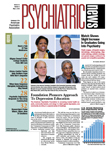Stigma may not be as big a barrier to help seeking by college students as previously thought, according to a study published in the April Psychiatric Services. Researchers at the University of Michigan found that perceived stigma was not associated with students' mental health service utilization.
“There is limited evidence of the long-term effectiveness of antistigma programs, and while our study is far from definitive, it does suggest that perceived stigma may not play as important a role in help seeking as many assume,” lead author Ezra Golberstein, a doctoral candidate in health policy at the University of Michigan, told Psychiatric News.
Many programs targeting college students as well as the general public are based on the assumption that stigmatizing attitudes surrounding mental illness keep many from seeking help. Yet Goberstein asserted that perhaps such assumptions should not be made so readily.
Golberstein and his colleagues randomly chose 2,782 graduate and undergraduate students enrolled at the university in fall 2005 and surveyed them about their attitudes toward seeking treatment for mental health problems, their perceived need for help, and whether they took psychotropic medications or received psychotherapy in the preceding year.
Using the Patient Health Questionnaire (PHQ), Golberstein also gathered information on whether the students were experiencing current symptoms of anxiety or depression.
Of those surveyed, 475 respondents screened positive for anxiety or depression on the PHQ. Among that group of respondents, 302 perceived a need for help over the prior year, and 156 of those did receive mental health services during that time.
As measured by the five-item Stigma Scale for Receiving Psychological Help, which ranges from 0 (very little perceived stigma associated with receiving mental health treatment) to 15 (high levels of perceived stigma), the mean score for the students surveyed was 5.8.
The scale features statements such as, “Receiving treatment for emotional or mental problems carries social stigma,” and students were asked to indicate their level of agreement with such statements on a continuum.
Men, Asian or Pacific Islanders, international students, and those who classified themselves as growing up “poor” perceived higher levels of stigma associated with mental illness treatment than did women, whites, U.S. students, or those who considered themselves “comfortable” or“ well-to-do” while growing up.
When the sample was stratified by age, 18- to 22-year olds who perceived more stigma attached to the use of mental health services were less likely to perceive a need for help, but this finding did not hold for those older than age 22. Among students with probable depressive or anxiety disorders, perceived stigma was not found to be associated with service use.
The researchers noted that one of the most surprising findings for the full sample of respondents was the lack of association between perceived stigma concerning mental health treatment and actual use of treatment.
According to Golberstein, one explanation for this finding is that the sample represents “a segment of society with relatively high socioeconomic status and education, and perceived stigma may not affect this specific population that much.”
Study limitations include a lack of generalizability of the results to the general population and the fact that researchers could not gather information about students' attitudes toward mental illness itself with the instrument used, which measured attitudes toward treatment for mental illness only.“ Although our study suggests that perceived stigma does not explain much of why students who might benefit from treatment do not use it, this is only one cross-sectional data point at one school,” Golberstein said, noting that he is currently gathering longitudinal data from students at a number of U.S. colleges to overcome that limitation.
The findings do not mean, however, that antistigma programs are not necessary.
Golberstein emphasized that antistigma programs targeting college students and adults “are very valuable even if they do not increase service use, since stigma is a form of discrimination that has been shown to have negative consequences for those with mental disorders.”
Prior research by Golberstein and colleagues published in the July 2007 Medical Care indicated that college students often face other barriers to getting mental health care, he noted. These barriers include inadequate knowledge about available services such as that the college offered free mental health care, having poor impressions of the effectiveness of treatment, and not knowing whether their health insurance covered mental health services.
“It might be more efficient to first focus on some of [these] barriers to care,” he told Psychiatric News, “although more research in this area is needed.”
